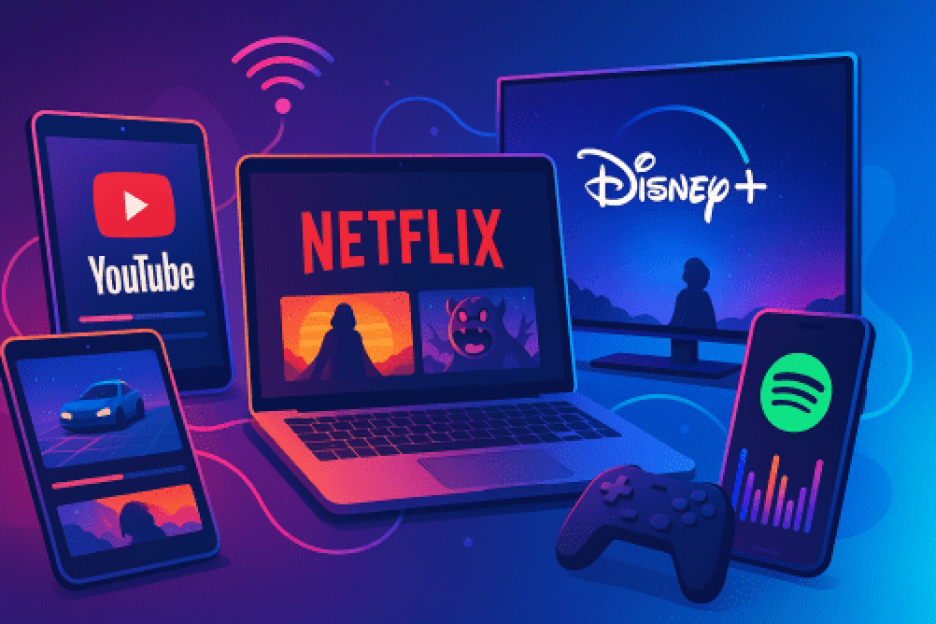The Modern Lifestyle Dilemma
In a world where everyone is connected, always logged in, and constantly scrolling, the need for intentional digital leisure is more relevant than ever. Whether it’s escaping into a movie, sinking into a video game, or diving into a relaxing mobile app, millions now turn to their devices not just for work or socializing, but for recovery.
This is especially true in 2025, where balancing work and personal life often requires active effort. What used to be idle downtime, reading a magazine, taking a walk, or zoning out, has transformed into a curated form of digital escape. And it’s not all bad.
Digital Leisure Is Not Just Screen Time
The term “screen time”; has a negative connotation, but that’s a simplistic way to view modern habits. Watching a series on Netflix , exploring a virtual museum, or playing a strategy game can offer real benefits, stress reduction, improved cognitive flexibility, and even social connection when shared with friends.
The difference lies in the intention. Are you passively scrolling, or are you actively engaging? Intentional digital leisure is immersive and restorative. It’s the new way people recharge.
New Categories of Digital Escape
Not all digital escapes are created equal. Let’s break down some of the most popular digital leisure categories today:
1. Interactive Entertainment
This includes mobile and console gaming, streaming platforms like Twitch, or choose-your-own-adventure apps. These platforms thrive on participation and keep users mentally engaged.
2. Casual Creativity
Apps like Procreate, Canva, or mobile music mixers encourage creativity without pressure. These tools allow people to create for the sake of fun, not productivity.
3. Mindful Escapes
Calm, Headspace, and similar apps represent a new wave of leisure centered on mindfulness. Breathing guides, nature sounds, or guided meditations all fall here.
4. Digital Gambling and Risk-Reward Games
This area has grown fast, particularly among users looking for short, engaging sessions with potential financial reward. Platforms in this space blend gameplay with the psychology of risk and excitement. For instance, Stake Casino brand is a global platform where players engage with real-money games that rely on crypto technology and provably fair mechanics. It reflects the broader trend of gamified experiences paired with digital currencies.
Why This Trend Is Growing
There are a few key reasons why more people are turning to digital leisure:
- Accessibility: All you need is a phone or a tablet, and the world of immersive escape is at your fingertips. No travel or planning is required.
- Low Commitment: Unlike traditional hobbies, digital escapes don’t require extensive gear, schedules, or investment. You can start and stop whenever you want.
- Instant Gratification: Whether it’s the next episode in a binge series or a level-up in a mobile game, these platforms are designed to offer small rewards that trigger dopamine and keep stress at bay.
- Social Integration: From Discord communities to in-app multiplayer chats, most platforms now build in a way to feel less alone. This helps users form micro-communities based on their preferred type of escape.
The Balance: Screen Hygiene Still Matters
All this said, balance is essential. Overindulging in digital leisure can backfire, especially if it replaces sleep, exercise, or in-person connection. Experts recommend setting boundaries:
- Use built-in timers or focus modes
- Rotate between passive (e.g., watching) and active (e.g., gaming, creating) digital activities
- Take screen-free breaks throughout the day
- Prioritize platforms that align with personal wellness goals, not just convenience
Future of Digital Leisure
The next wave of online leisure may integrate more AI personalization, virtual reality, and biometric feedback. Companies are already developing apps that adjust gameplay, brightness, or pace based on user stress levels or heart rate. Imagine a meditation app that adapts its rhythm to your breath, or a mobile game that modifies challenge levels based on cognitive fatigue.
Another strong signal is the growth of immersive virtual hubs, decentralized platforms that offer a blend of casino, streaming, shopping, and gaming all within a single environment. These spaces mimic real-world economies and offer digital rewards, tokens, and ownership. The metaverse may have faded from headlines, but its core principles are being reworked into hybrid apps people already use every day.
Tips to Curate Your Own Digital Downtime
Creating a healthy and fulfilling digital escape routine doesn’t mean quitting social media or gaming. It means choosing wisely. Here are a few strategies:
- Curate your apps like you curate your wardrobe, keep only what fits and makes you feel good
- Schedule daily leisure sessions, even just 20 minutes
- Try new platforms that offer interactive or gamified features
- Mix in educational or wellness-focused content to keep the experience enriching
Conclusion: Digital Downtime Is Human
In the end, the impulse to escape, relax, and recharge is deeply human. What’s changed is the medium. Instead of a cabin in the woods, it’s now a corner of your phone or tablet. The best digital escapes blend pleasure with purpose and novelty with familiarity. Platforms that understand this will shape the next era of leisure, one tap at a time.








